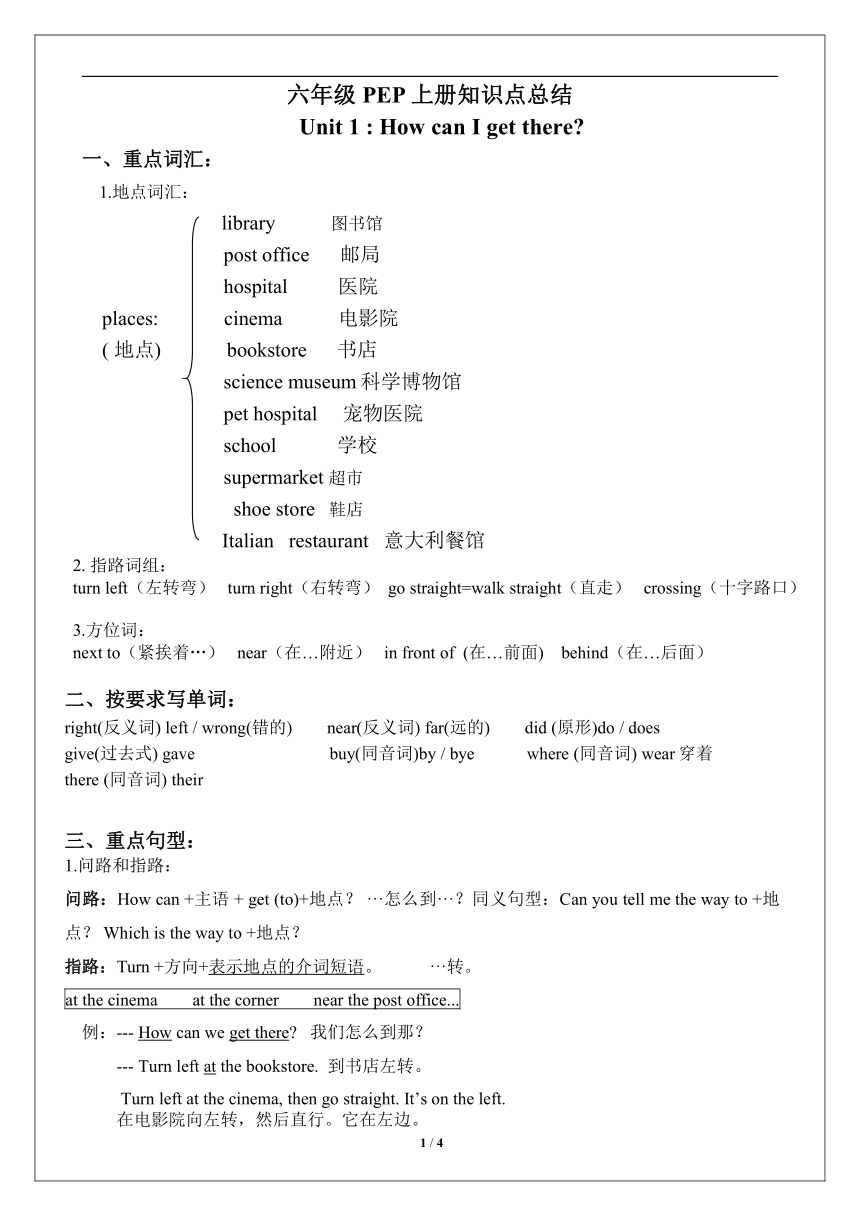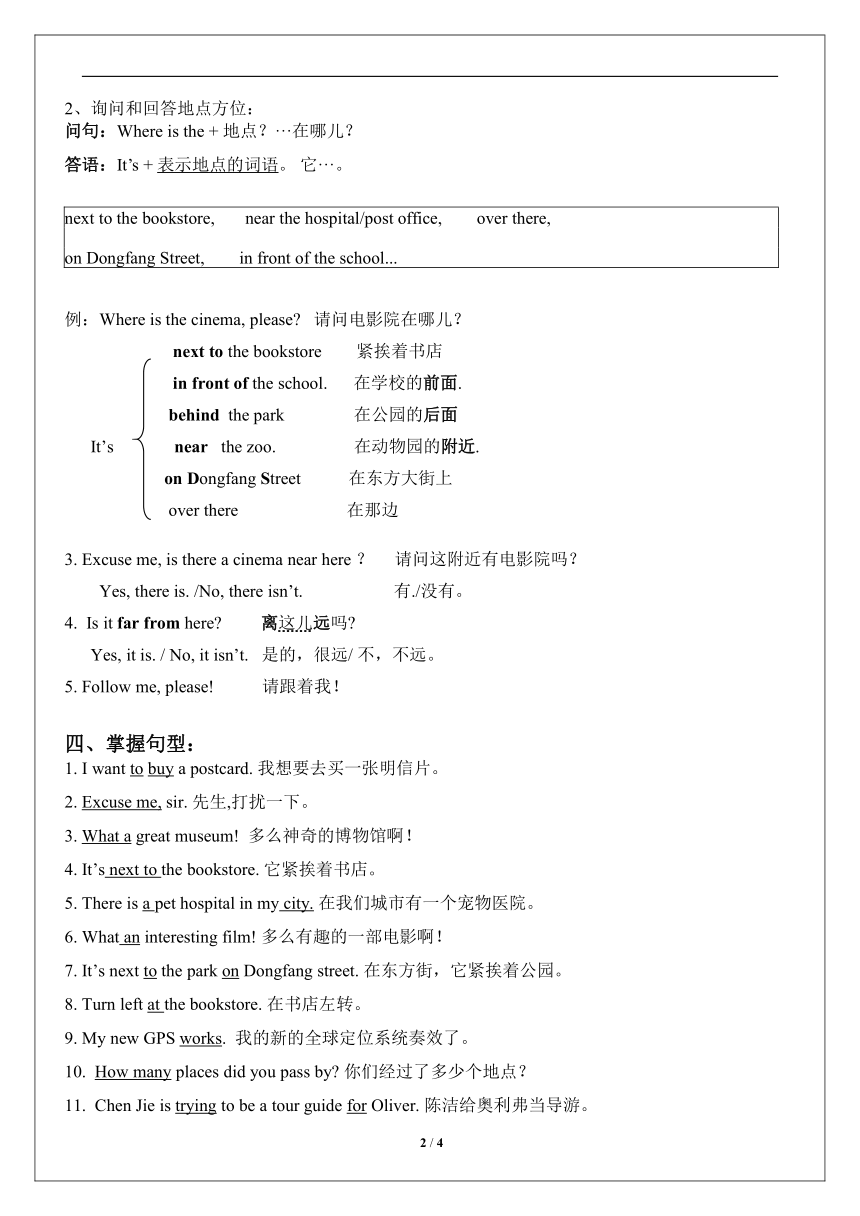人教版PEP小学英语六年级上册 Unit1知识点归纳
文档属性
| 名称 | 人教版PEP小学英语六年级上册 Unit1知识点归纳 |  | |
| 格式 | zip | ||
| 文件大小 | 64.0KB | ||
| 资源类型 | 教案 | ||
| 版本资源 | 人教版(PEP) | ||
| 科目 | 英语 | ||
| 更新时间 | 2020-06-17 18:27:05 | ||
图片预览


文档简介
六年级PEP上册知识点总结
Unit
1
:
How
can
I
get
there?
一、重点词汇:
1.地点词汇:
library
图书馆
post
office
邮局
hospital
医院
places:
cinema
电影院
(
地点)
bookstore
书店
science
museum科学博物馆
pet
hospital
宠物医院
school
学校
supermarket
超市
shoe
store
鞋店
Italian
restaurant
意大利餐馆
2.
指路词组:
turn
left(左转弯)
turn
right(右转弯)
go
straight=walk
straight(直走)
crossing(十字路口)
3.方位词:
next
to(紧挨着…)
near(在…附近)
in
front
of
(在…前面)
behind(在…后面)
二、按要求写单词:
right(反义词)
left
/
wrong(错的)
near(反义词)
far(远的)
did
(原形)do
/
does
give(过去式)
gave
buy(同音词)by
/
bye
where
(同音词)
wear穿着
there
(同音词)
their
三、重点句型:
1.问路和指路:
问路:How
can
+主语
+
get
(to)+地点?
···怎么到···?同义句型:Can
you
tell
me
the
way
to
+地点?
Which
is
the
way
to
+地点?
指路:Turn
+方向+表示地点的介词短语。
···转。
at
the
cinema
at
the
corner
near
the
post
office...
例:---
How
can
we
get
there?
我们怎么到那?
---
Turn
left
at
the
bookstore.
到书店左转。
Turn?left?at?the?cinema,?then?go?straight.?It’s?on?the?left.??
在电影院向左转,然后直行。它在左边。
2、询问和回答地点方位:
问句:Where
is
the
+
地点?···在哪儿?
答语:It’s
+
表示地点的词语。
它···。
next
to
the
bookstore,
near
the
hospital/post
office,
over
there,
on
Dongfang
Street,
in
front
of
the
school...
例:Where
is
the
cinema,
please?
请问电影院在哪儿?
next
to
the
bookstore
紧挨着书店
in
front
of
the
school.
在学校的前面.
behind
the
park
在公园的后面
It’s
near
the
zoo.
在动物园的附近.
on
Dongfang
Street
在东方大街上
over
there
在那边
3.
Excuse
me,
is
there
a
cinema
near
here
?
请问这附近有电影院吗?
Yes,
there
is.
/No,
there
isn’t.
有./没有。
4.
Is
it
far
from
here?
离这儿远吗?
Yes,
it
is.
/
No,
it
isn’t.
是的,很远/
不,不远。
5.
Follow
me,
please!
请跟着我!
四、掌握句型:
1.
I
want
to
buy
a
postcard.
我想要去买一张明信片。
2.
Excuse
me,
sir.
先生,打扰一下。
3.
What
a
great
museum!
多么神奇的博物馆啊!
4.
It’s
next
to
the
bookstore.
它紧挨着书店。
5.
There
is
a
pet
hospital
in
my
city.
在我们城市有一个宠物医院。
6.
What
an
interesting
film!
多么有趣的一部电影啊!
7.
It’s
next
to
the
park
on
Dongfang
street.
在东方街,它紧挨着公园。
8.
Turn
left
at
the
bookstore.
在书店左转。
9.
My
new
GPS
works.
我的新的全球定位系统奏效了。
10.
How
many
places
did
you
pass
by?
你们经过了多少个地点?
11.
Chen
Jie
is
trying
to
be
a
tour
guide
for
Oliver.
陈洁给奥利弗当导游。
五、语法:
1.
Where
is
the
museum
shop?
此问句是由特殊疑问词where
引导的一个特殊疑问句,
构成为:特殊疑问词
+
一般疑问句
where意为“在哪里,
到哪里”,
用来询问地点,
放在句子的开头。
1.询问“某人或某物在哪里”的基本句型是:“
Where
+is/are+
主语?”,
where
is
后接名词或代词的单数形式,
where
are
后接名词或代词的复数形式。
2.回答时问题中的地点名词用it
/
they代替,句型结构为:
---It’s
/
They’re
near
the
door.
3.句型结构:
It’s
/
They’re
+
方位词
+
地点名词.
意为:“……在哪里。”
注意:it’s
=
it
is
they’re
=
they
are
2.
It’s
near
the
door.
此句中near是表示位置的介词,
意为“旁边,附近”
,
其同义句是:It’s
next
to
the
door.它在门的旁边。
注意:
near
与
next
to
的区别
near
在……附近
(范围大,距离较远)
next
to
紧挨着…
(距离很近)
表示位置的短语:
next
to
the
bookstore挨着书店
near
the
hospital在医院附近
near
the
post
office在邮局附近
over
there
在那边
on
Dongfang
Street在东方大街上
in
front
of
the
school在学校前面
3.
How
can
we
get
there?
此句用来询问“怎样去某地”,
后面直接跟地点。
回答时,
可以用“
Turn
left,
turn
right,
go
straight.”等句来回答。
例如:Turn
left
at
the
bookstore.
同义句:Where
is
the
+地点?
4.
Turn
left
at
the
bookstore.
Then
turn
right
at
the
hospital.
此句是指路的句型。
常用到的句型有:turn
left,
向左转turn
right,
向右转go
straight直着走。同时表示在某处的介词用at.
(?http:?/??/?www.xkb1.com?/??)
5.
Is
the
Thames
far
from
here?
No,
it
isn’t.
此句是个be动词开头的一般疑问句,
其回答要用Yes或No.
句中的far
from意为“离……远”。反义词组为next
to/near.
6.
介词at,
on,
in
表示地点的用法:
at
+
小地点
in
+
大地点、中间
on
+
街道、左右
例:at
Wanning
/
the
crossing在万宁(相对于北京市是小地点)
/
十字路口
in
Beijing
在北京
in
front
of在……前面
in
the
middle
of
在中间
on
Dongfang
street
在东方大街
on
the
left/right在左边、右边
7.
want,
will的用法:
want
to
do
sth.
想要做某事
例:I
want
to
buy
a
postcard.
我想要买一张明信片。
will(将要)
+
动词原形
例:I’ll
/
I
will
ask
a
policeman
for
help.
我将向警察求助。
8.
动词
+
宾格
例如:
Can
you
help
her?
(你能帮助她吗?her是宾格)
Follow
me,
please!
(请跟着我!me是宾格)
9.
主语是第三人单数时,动词后面要加s或es.
My
new
GPS
works.
(我的新的全球定位系统奏效了。works
是work的第三人称单数)
六、作文:
How
to
Get
to
the
Science
Museum
We
are
going
to
the
science
museum
tomorrow.
The
science
museum
is
next
to
the
hospital.
It’s
not
far
from
our
school.
So
we
can
go
there
on
foot.
First,
go
straight
from
our
school.
Next,
turn
left
at
the
post
office
and
walk
for
about
five
minutes.
Then
turn
right
at
the
bookstore.
We
can
find
the
hospital
is
on
the
right.
Last,
Go
straight
and
we’ll
see
the
science
museum.
PAGE
2
/
2
Unit
1
:
How
can
I
get
there?
一、重点词汇:
1.地点词汇:
library
图书馆
post
office
邮局
hospital
医院
places:
cinema
电影院
(
地点)
bookstore
书店
science
museum科学博物馆
pet
hospital
宠物医院
school
学校
supermarket
超市
shoe
store
鞋店
Italian
restaurant
意大利餐馆
2.
指路词组:
turn
left(左转弯)
turn
right(右转弯)
go
straight=walk
straight(直走)
crossing(十字路口)
3.方位词:
next
to(紧挨着…)
near(在…附近)
in
front
of
(在…前面)
behind(在…后面)
二、按要求写单词:
right(反义词)
left
/
wrong(错的)
near(反义词)
far(远的)
did
(原形)do
/
does
give(过去式)
gave
buy(同音词)by
/
bye
where
(同音词)
wear穿着
there
(同音词)
their
三、重点句型:
1.问路和指路:
问路:How
can
+主语
+
get
(to)+地点?
···怎么到···?同义句型:Can
you
tell
me
the
way
to
+地点?
Which
is
the
way
to
+地点?
指路:Turn
+方向+表示地点的介词短语。
···转。
at
the
cinema
at
the
corner
near
the
post
office...
例:---
How
can
we
get
there?
我们怎么到那?
---
Turn
left
at
the
bookstore.
到书店左转。
Turn?left?at?the?cinema,?then?go?straight.?It’s?on?the?left.??
在电影院向左转,然后直行。它在左边。
2、询问和回答地点方位:
问句:Where
is
the
+
地点?···在哪儿?
答语:It’s
+
表示地点的词语。
它···。
next
to
the
bookstore,
near
the
hospital/post
office,
over
there,
on
Dongfang
Street,
in
front
of
the
school...
例:Where
is
the
cinema,
please?
请问电影院在哪儿?
next
to
the
bookstore
紧挨着书店
in
front
of
the
school.
在学校的前面.
behind
the
park
在公园的后面
It’s
near
the
zoo.
在动物园的附近.
on
Dongfang
Street
在东方大街上
over
there
在那边
3.
Excuse
me,
is
there
a
cinema
near
here
?
请问这附近有电影院吗?
Yes,
there
is.
/No,
there
isn’t.
有./没有。
4.
Is
it
far
from
here?
离这儿远吗?
Yes,
it
is.
/
No,
it
isn’t.
是的,很远/
不,不远。
5.
Follow
me,
please!
请跟着我!
四、掌握句型:
1.
I
want
to
buy
a
postcard.
我想要去买一张明信片。
2.
Excuse
me,
sir.
先生,打扰一下。
3.
What
a
great
museum!
多么神奇的博物馆啊!
4.
It’s
next
to
the
bookstore.
它紧挨着书店。
5.
There
is
a
pet
hospital
in
my
city.
在我们城市有一个宠物医院。
6.
What
an
interesting
film!
多么有趣的一部电影啊!
7.
It’s
next
to
the
park
on
Dongfang
street.
在东方街,它紧挨着公园。
8.
Turn
left
at
the
bookstore.
在书店左转。
9.
My
new
GPS
works.
我的新的全球定位系统奏效了。
10.
How
many
places
did
you
pass
by?
你们经过了多少个地点?
11.
Chen
Jie
is
trying
to
be
a
tour
guide
for
Oliver.
陈洁给奥利弗当导游。
五、语法:
1.
Where
is
the
museum
shop?
此问句是由特殊疑问词where
引导的一个特殊疑问句,
构成为:特殊疑问词
+
一般疑问句
where意为“在哪里,
到哪里”,
用来询问地点,
放在句子的开头。
1.询问“某人或某物在哪里”的基本句型是:“
Where
+is/are+
主语?”,
where
is
后接名词或代词的单数形式,
where
are
后接名词或代词的复数形式。
2.回答时问题中的地点名词用it
/
they代替,句型结构为:
---It’s
/
They’re
near
the
door.
3.句型结构:
It’s
/
They’re
+
方位词
+
地点名词.
意为:“……在哪里。”
注意:it’s
=
it
is
they’re
=
they
are
2.
It’s
near
the
door.
此句中near是表示位置的介词,
意为“旁边,附近”
,
其同义句是:It’s
next
to
the
door.它在门的旁边。
注意:
near
与
next
to
的区别
near
在……附近
(范围大,距离较远)
next
to
紧挨着…
(距离很近)
表示位置的短语:
next
to
the
bookstore挨着书店
near
the
hospital在医院附近
near
the
post
office在邮局附近
over
there
在那边
on
Dongfang
Street在东方大街上
in
front
of
the
school在学校前面
3.
How
can
we
get
there?
此句用来询问“怎样去某地”,
后面直接跟地点。
回答时,
可以用“
Turn
left,
turn
right,
go
straight.”等句来回答。
例如:Turn
left
at
the
bookstore.
同义句:Where
is
the
+地点?
4.
Turn
left
at
the
bookstore.
Then
turn
right
at
the
hospital.
此句是指路的句型。
常用到的句型有:turn
left,
向左转turn
right,
向右转go
straight直着走。同时表示在某处的介词用at.
(?http:?/??/?www.xkb1.com?/??)
5.
Is
the
Thames
far
from
here?
No,
it
isn’t.
此句是个be动词开头的一般疑问句,
其回答要用Yes或No.
句中的far
from意为“离……远”。反义词组为next
to/near.
6.
介词at,
on,
in
表示地点的用法:
at
+
小地点
in
+
大地点、中间
on
+
街道、左右
例:at
Wanning
/
the
crossing在万宁(相对于北京市是小地点)
/
十字路口
in
Beijing
在北京
in
front
of在……前面
in
the
middle
of
在中间
on
Dongfang
street
在东方大街
on
the
left/right在左边、右边
7.
want,
will的用法:
want
to
do
sth.
想要做某事
例:I
want
to
buy
a
postcard.
我想要买一张明信片。
will(将要)
+
动词原形
例:I’ll
/
I
will
ask
a
policeman
for
help.
我将向警察求助。
8.
动词
+
宾格
例如:
Can
you
help
her?
(你能帮助她吗?her是宾格)
Follow
me,
please!
(请跟着我!me是宾格)
9.
主语是第三人单数时,动词后面要加s或es.
My
new
GPS
works.
(我的新的全球定位系统奏效了。works
是work的第三人称单数)
六、作文:
How
to
Get
to
the
Science
Museum
We
are
going
to
the
science
museum
tomorrow.
The
science
museum
is
next
to
the
hospital.
It’s
not
far
from
our
school.
So
we
can
go
there
on
foot.
First,
go
straight
from
our
school.
Next,
turn
left
at
the
post
office
and
walk
for
about
five
minutes.
Then
turn
right
at
the
bookstore.
We
can
find
the
hospital
is
on
the
right.
Last,
Go
straight
and
we’ll
see
the
science
museum.
PAGE
2
/
2
同课章节目录
